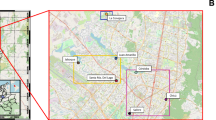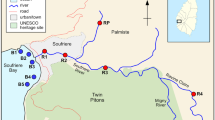Abstract
During the Korean foot-and-mouth disease outbreak in 2010–2011, about 3.38 million pigs and cattle were slaughtered and disposed into 4,600 burial pits around the country. In this study, the hydrogeochemical characteristics of landfill leachate and its impact on microbial communities in soils and groundwater were investigated at two hydrogeologically different burial sites; one disposal site (landfill D) is located in a flat area, and the other (landfill Y) is located on a mountain slope. The hydrogeochemical parameters (i.e., EC, HCO3 −, Cl−, Ca2+, DOC, and NH4 +) in the monitoring well of landfill Y showed higher values than those in landfill D. The EC, Cl−, HCO3 −, Ca2+, DOC, and NH4 + values increased until July and decreased in October 2011, because the leachate was regularly pumped and treated during the summer, and water recharged by summer precipitation was infiltrated into the landfill. Relatively anaerobic conditions were observed in monitoring wells (I107-1 and Y-1) at two disposal sites with low DO, NO3 −, and SO4 2− and high Fe2+ and Mn2+ concentration. The dynamic of microbial community structure of aquifers and leachate from animal carcass disposal was analyzed using 16S rRNA gene-based pyrosequencing. Microbial communities affected by the release of landfill leachate at the two burial sites showed clear differences from each other. Bacterial communities in background water (BA-1) and in the aquifer of landfill D were similar, whereas the aquifer (Y-1) and leachate (Y-2) of landfill Y had bacterial communities that had significantly deviated from those of background water. Microbial communities in their groundwater monitoring wells showed distinct patterns due to the amount of leachate caused by hydraulic gradient in each landfill. This finding indicates that hydrogeological conditions are critically important for establishing a landfill site and controlling landfill leachate.






Similar content being viewed by others
References
Atlas RM, Horowitz A, Krichevsky M, Bej AK (1991) Responses of microbial populations to environmental disturbance. Microb Ecol 22:249–256
Barella CF, Bacellar LAP, Nalini HA (2013) Influence of the natural oxidation of the leachate organic fraction from a landfill on groundwater quality, Balo Horizonte: minas Gerais, south-eastern Brazil. Environ Earth Sci 70:2283–2292
Bjerg PL, Tuxen N, Reitzel LA, Albrechtsen H, Kjeldsen P (2011) Natural attenuation processes in landfill leachate plumes at three danish sites. Ground Water 49:688–705
Bray JR, Curtis JT (1957) An ordination of upland forest communities of southern Wisconsin. Ecol Monogr 27:325–349
Chao A, Bunge J (2002) Estimating the number of species in a stochastic abundance model. Biometrics 58:531–539
Cho JC, Kim SJ (2000) Increase in bacterial community diversity in subsurface aquifers receiving livestock wastewater input. Appl Environ Microbiol 66:956–965
Cho JC, Cho HB, Kim SJ (2000) Heavy contamination of a subsurface aquifer and a stream by livestock wastewater in a stock farming area, a Wonju, Korea. Environ Pollut 109:137–146
Chun J, Lee J, Jung Y, Kim S, Kim B, Lim Y (2007) EzTaxon: a web-based tool for the identification of prokaryotes based on 16S ribosomal RNA gene sequences. Int J Syst Evol Microbiol 57:2259–2261
Cozzarelli IM, Suflita JM, Ulrich GA, Harris SH, Scholl MA, Schlottmann JL, Christenson S (2000) Geochemical and microbiological methods for evaluating anaerobic processes in an aquifer contaminated by landfill leachate. Environ Sci Technol 34:4025–4033
Cozzarelli IM, Böhlke JK, Masoner J, Breit GN, Lorah MM, Tuttle MLW, Jaeschke JB (2011) Biogeochemical evolution of a landfill leachate plume, Norman, Oklahoma. Groundwater 49(5):663–687
Fahrenfeld N, Cozzarelli IM, Bailey Z, Pruden A (2014) Insights into biodegradation through depth-resolved microbial community functional and structural profiling of a crude-oil contaminant plume. Microb Ecol 68(3):453–462
Griebler C, Lueders T (2009) Microbial biodiversity in groundwater ecosystems. Freshw Biol 54:649–677
Hackley KC, Liu CL, Coleman DD (1996) Environmental isotope characteristics of landfill leachate and gases. Ground Water 34:827–836
Hedrich S, Schlomann M, Johnson DB (2011) The iron-oxidizing proteobacteria. Microbiology 157:1551–1564
Johnson A, Llewellyn N, Smith J, van der Gast C, Lilley A, Singer A, Thompson I (2004) The role of microbial community composition and groundwater chemistry in determining isoproturon degradation potential in UK aquifers. FEMS Microbiol Ecol 49:71–82
Kim K, Kim K, Kim H, Lee G, Lee K (2010) Assessment of soil and groundwater contamination at two animal carcass disposal sites. Korean J Soil Sci Fertil 43:384–389
Kjeldsen P (1993) Groundwater pollution source characterization of an old landfill. J Hydrol 142:349–371
Korea Ministry of Environment (2010) Environmental management guideline of carcass burial sites. Seoul, pp 1–29
Koshy L, Paris E, Ling S, Jones T, Be´ruBe´ K (2007) Bioreactivity of leachate from municipal solid waste landfills—assessment of toxicity. Sci Total Environ 384:171–181
Kumar AR, Riyazuddin P (2012) Seasonal variation of redox species and redox potentials in shallow groundwater: a comparison of measured and calculated redox potentials. J Hydrol 444:187–198
Lee KK (2011) FMDV landfill leachate and groundwater contamination. Korean Geo-environ Soc 4:6–17
Lim SY, Kim S, Yeon K, Sang B, Chun J, Lee C (2012) Correlation between microbial community structure and biofouling in a laboratory scale membrane bioreactor with synthetic wastewater. Desalination 287:209–215
Lu Z, He Z, Parisi VA, Kang S, Deng Y, Van Nostrand JD, Masoner JR, Cozzarelli IM, Suflita JM, Zhou J (2012) GeoChip-based analysis of microbial functional gene diversity in a landfill leachate-contaminated aquifer. Environ Sci Technol 46(11):5824–5833
Martín R, Jiménez E, Olivares M, Marín ML, Fernández L, Xaus J, Rodríguez JM (2006) Lactobacillus salivarius CECT 5713, a potential probiotic strain isolated from infant feces and breast milk of a mother-child pair. Int J Food Microbiol 112:35–43
Mendoza-Sanchez I, Phanikumar MS, Niu J, Masoner JR, Cozzarelli IM, McGuire JT (2013) Quantifying wetland–aquifer interactions in a humid subtropical climate region: an integrated approach. J Hydrol 498:237–253
Nicholson RV, Cherry JA, Reardon EJ (1983) Migration of contaminants in groundwater at a landfill: a case study. J Hydrol 63:131–176
Pearce A, Rizzo DM, Mouser PJ (2011) Subsurface characterization of groundwater contaminated by landfill leachate using microbial community profile data and a nonparametric decision-making process. Water Resour Res 47:W06511. doi:10.1029/2010WR009992
Pratt DL (2009) Environmental impact of livestock mortalities burial. MS thesis, Department of Agricultural and Bioresource Engineering, University of Saskatchewan, Saskatchewan, Canada
Ramalho EC, Dill AC, Rocha R (2013) Assessment of the leachate movement in a sealed landfill using geophysical methods. Environ Earth Sci 68:343–354
Rao SM, Sekhar M, Rao PR (2013) Impact of pit-toilet leachate on groundwater chemistry and role of vadose zone in removal of nitrate and E. coli pollutants in Kolar District, Karnataka, India. Environ Earth Sci 68:927–938
Ritter WF, Chrinside AEM (1995) Impact of dead bird disposal pits on groundwater quality on the Delmarva peninsula. Bioresource Technol 53:105–111
Rogosa M, Wiseman RF, Mitchell JA, Disraely MN, Beaman AJ (1953) Species differentiation of oral lactobacilli from man including descriptions of Lactobacillus salivarius nov. spec. and Lactobacillus cellobiosus nov. spec. J Bacteriol 65:681–699
Röling WFM, Breukelen BM, Braster M, Lin B, van Verseveld H (2001) Relation between microbial community structure and hydrochemistry in a landfill leachate-polluted aquifer. Appl Environ Microbiol 67:4619–4629
Scholl AM, Cozzarelli MI, Christenson CS (2006) Recharge processes drive sulfate reduction in an alluvial aquifer contaminated with landfill leachate. J Contamin Hydrol 86:239–261
Spring S, Wagner M, Schumann P, Kampfer P (2005) Malikia granosa gen. nov., sp. nov., a novel polyhydroxyalkanoate- and polyphosphate accumulating bacterium isolated from activated sludge, and reclassification of Pseudomonas spinosa as Malikia spinosa comb. nov. Int J Syst Evol Microbiol 55:621–629
Torsvik V, Daae FL, Sandaa RA, Ovreas L (1998) Novel techniques for analyzing microbial diversity in natural and perturbed environments. J Biotechnol 64:53–62
United Kingdom Department of Health (2003) Foot and Mouth Disease. United Kingdom, London
Unno T, Jang J, Han D, Kim J, Sadowsky MJ, Kim O, Chun J, Hur H (2010) Use of barcode pyrosequencing and shared OTUs to determine source of fecal bacteria in watersheds. Environ Sci Technol 44:7777–7782
Wartiainen I, Hestnes AG, McDonald IR, Svenning MM (2006) Methylobacter tundripaludum sp. nov., a methane-oxidizing bacterium from Arctic wetland soil on the Svalbard islands, Norway (78°N). Int J Syst Evol Microbiol 56:109–113
Weng H, Zhang F, Zhu Y, Qin Y, Ji Z, Cheng C (2011) Treatment of leachate from domestic landfills with three-stage physicochemical and biochemical technology. Environ Earth Sci 64:1675–1681
Wijesekara SSRMDHR, Mayakaduwa SS, Siriwardana AR, Silva N, Kawamoto BK, Vithanage M (2014) Fate and transport of pollutant through a municipal solid waste landfill leachate in Sri Lanka. Environ Earth Sci 72:1707–1719
Acknowledgments
This work was supported by a National Research Foundation of Korea Grant funded by the Korean Government [NRF-2012R1A1A3013672] and the Brain Korea 21 Project (through the School of Earth and Environmental Sciences, Seoul National University) in 2014. The valuable comments of Dr. Cho Jangcheon (Inha University) are gratefully acknowledged.
Author information
Authors and Affiliations
Corresponding author
Rights and permissions
About this article
Cite this article
Kaown, D., Kim, H., Moon, H.S. et al. Hydrogeochemical and microbial characteristics in aquifers contaminated with leachate from animal carcass disposal sites. Environ Earth Sci 73, 4647–4657 (2015). https://doi.org/10.1007/s12665-014-3750-3
Received:
Accepted:
Published:
Issue Date:
DOI: https://doi.org/10.1007/s12665-014-3750-3




